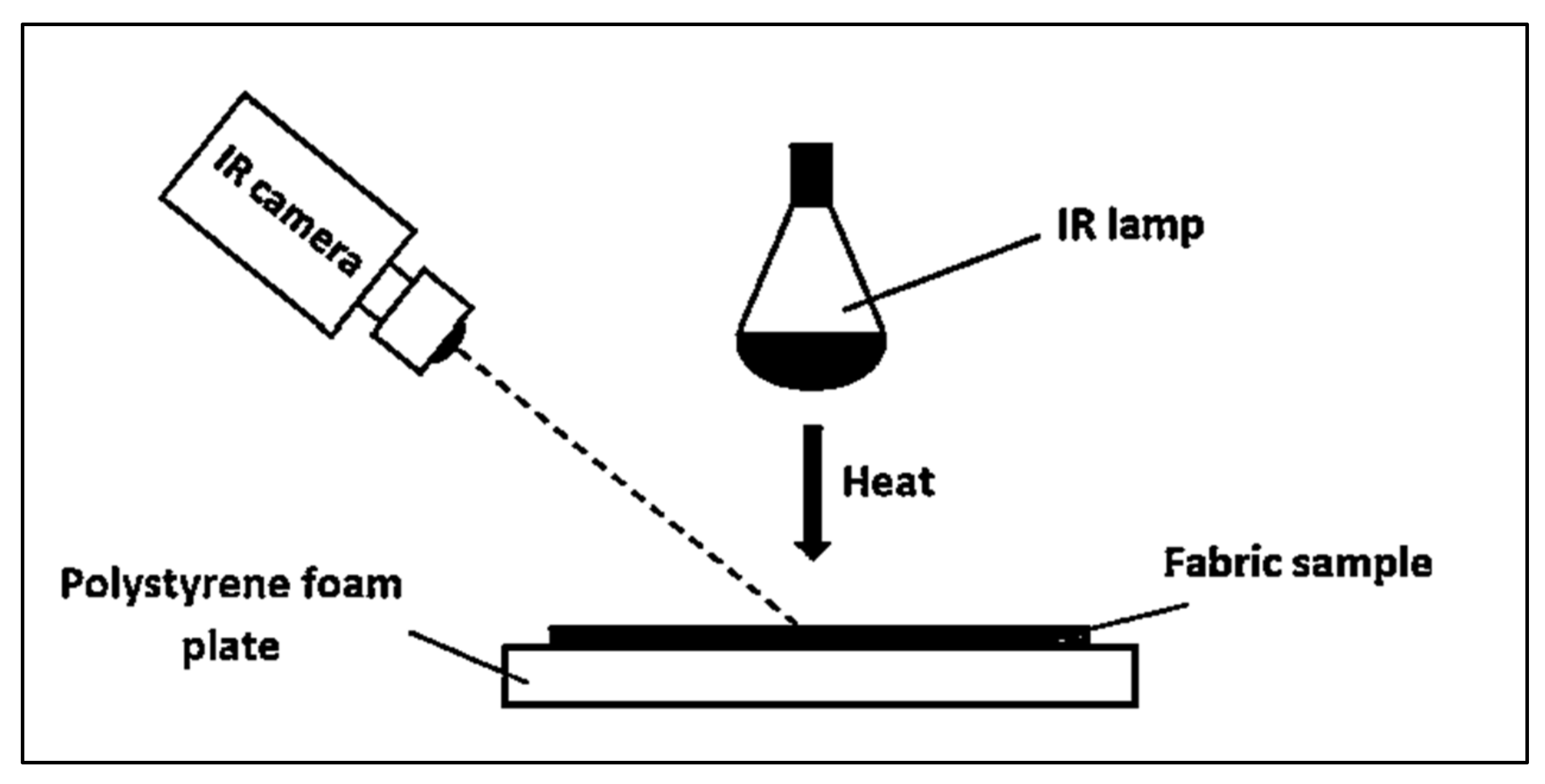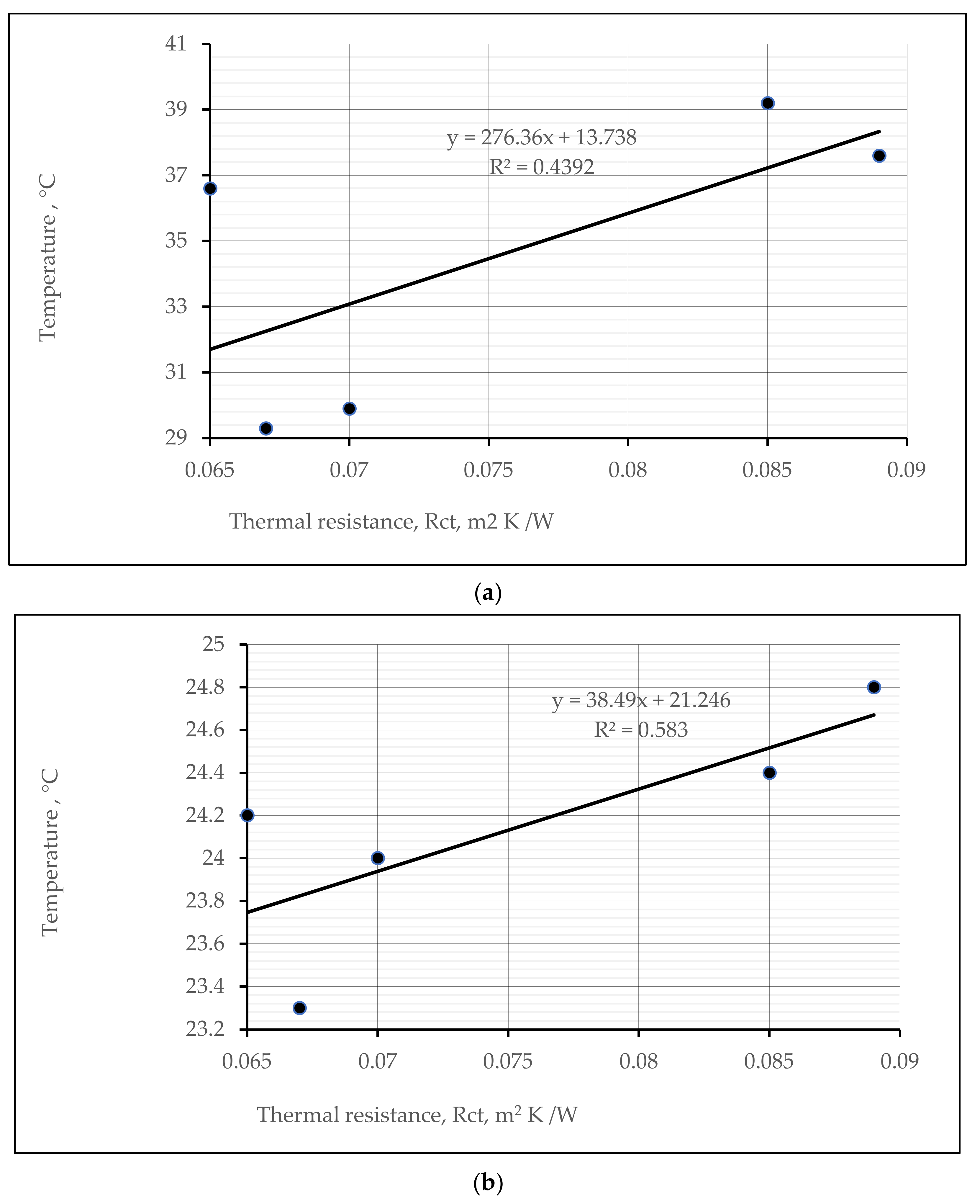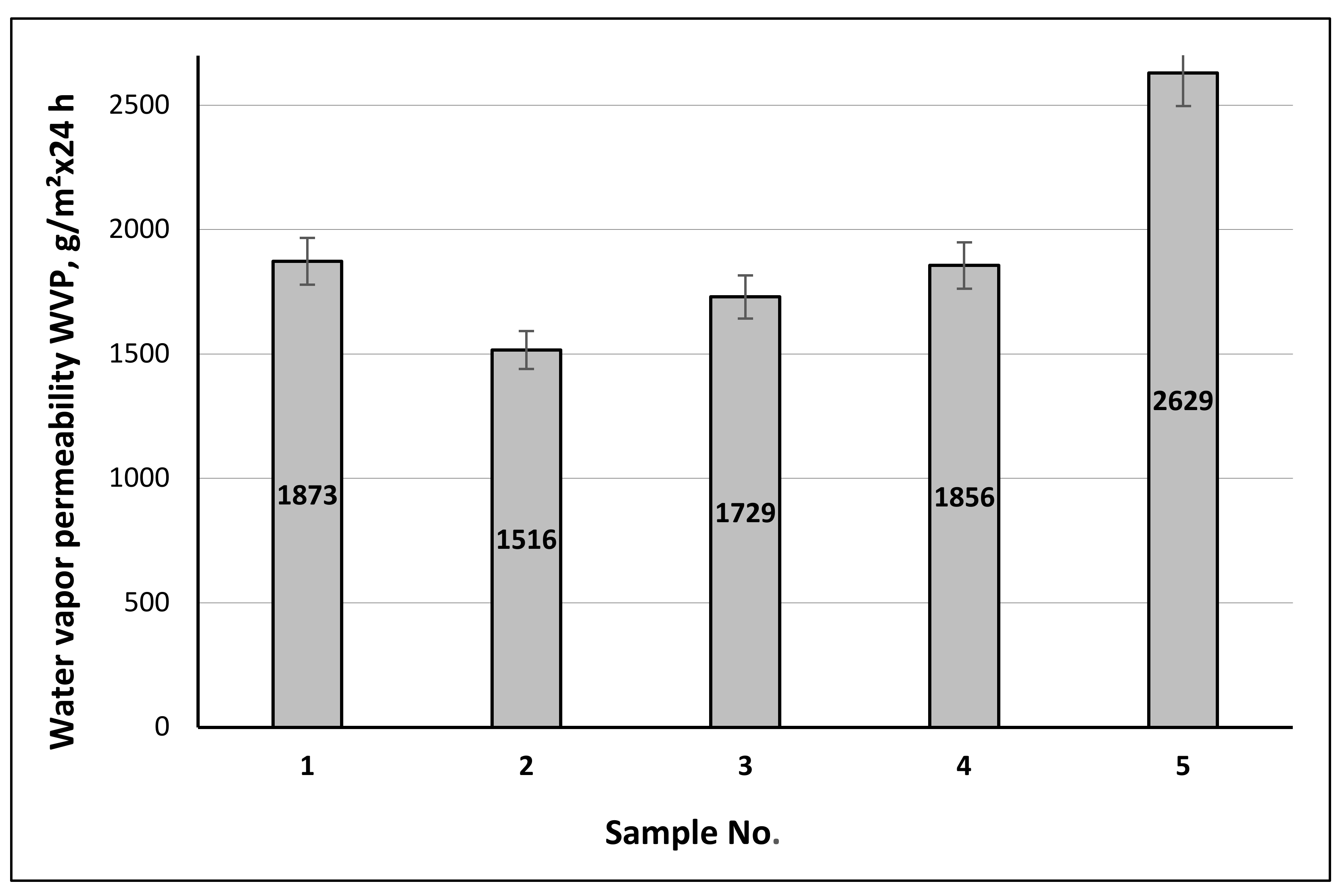Thermal Comfort and Electrostatic Properties of Socks Containing Fibers with Bio-Ceramic, Silver and Carbon Additives
Abstract
:1. Introduction
2. Materials and Methods
- 19.7 tex polyester (PES) spun yarns, Resistex® Bioceramic (Tecnofilati S.r.l., Bergamo, Italy);
- 7.8 tex (filament count—12) bicomponent PES/C, multifilament yarns with a trilobal-shaped carbon core, Nega-Stat® P190 (W. Barnet GmbH & Co. KG, Aachen, Germany);
- 11.2 tex (filament count—12) bicomponent PES/C multifilament yarns with a trilobal carbon cross section, which 3 segment exits to the PES fiber surface, Nega-Stat® P210 (W. Barnet GmbH & Co. KG, Aachen, Germany);
- 17.0 tex twisted (filament count: 32 + 12) PES silver (Ag)-coated multifilament yarns, Shieldex® (Statex Productions & Vertriebs GmbH, Bremen, Germany);
- 11.1 tex textured PES yarns (Hangzhou Tita Industry Co., Ltd., Zhejiang, China);
- 7.8 tex PA + 2.2 tex elastane (EL) air-intermingled yarns (Mistral—Elast Sp. z o.o., Łódź, Poland);
3. Results
4. Conclusions
Author Contributions
Funding
Institutional Review Board Statement
Informed Consent Statement
Conflicts of Interest
References
- Cimilli, S.; Nergis, B.U.; Candan, C.; Özdemir, M. A comparative study of some comfort-related properties of socks of different fiber types. Text. Res. J. 2010, 80, 948–957. [Google Scholar] [CrossRef]
- Goonetilleke, R.S. The Science of Footwear; CRC Press: Boca Raton, FL, USA, 2012. [Google Scholar]
- Oğlakcioğlu, N.; Marmarali, A. Thermal comfort properties of some knitted structures. Fibres Text. East. Eur. 2007, 64, 94–96. [Google Scholar]
- Zimniewska, M.; Laurentowska, M.; Bogacz, E.; Kryściak, J.; Domaszewska, K.; Zimniewska, O. Influence of sportswear made from polyester and man-made cellulosic fibres on the energy cost of physical effort. Fibres Text. East. Eur. 2010, 3, 94–99. [Google Scholar]
- Horrocks, A.R.; Anand, S.C. Handbook of Technical Textiles; Woodhead Publishing Limited: Sawston, UK, 2000. [Google Scholar]
- Skenderi, Z.; Čubrić, S.I.; Srdjak, M. Water Vapour Resistance of Knitted Fabrics under Different Environmental Conditions. Fibres Text. East. Eur. 2009, 2, 72–75. [Google Scholar]
- Miraftab, M. Comparison of air permeability and moisture management properties of jersey, interlock and pique knitted fabrics. J. Text. Inst. 2012, 2, 1–5. [Google Scholar]
- Meltem, Y.M.; Bilge, F.A.; Kalaoglu, F. A Study on the Influence of Knit Structure on Comfort Properties of Acrlic Knitted Fabrics. Smartex Res. J. 2012, 1, 88–92. [Google Scholar]
- Hes, L.; Ursache, M. Effect of Composition of Knitted Fabrics on their Cooling Efficiency at Simulated Sweating. Indian J. Fibre Text. Res. 2011, 36, 281–284. [Google Scholar]
- Sharabaty, T.; Biguenet, F.; Dupuis, D.; Viallier, P. Investigation on Moisture transport trough Polyester/Cotton Fabrics. Indian J. Fibre Text. Res. 2008, 419–425. [Google Scholar]
- Bivainytė, A.; Mikučionienė, D. Investigation on the air and water vapour permeability of double-layered weft knitted fabrics. Fibres Text. East. Eur. 2011, 3, 69–73. [Google Scholar]
- Gun, A.D.; Bodur, A. Thermo-physiological comfort properties of double-face knitted fabrics made from different types of polyester yarns and cotton yarn. J. Text. Inst. 2017, 108, 1518–1527. [Google Scholar] [CrossRef]
- Das, A.; Biswas, B. Study on heat and moisture vapour transmission characteristics through multilayered fabric ensembles. Indian J. Fibre Text. Res. 2011, 36, 410–414. [Google Scholar]
- Wilbik-Halgas, B.; Danych, R.; Wiecek, B.; Kowalski, K. Air and water vapour permeability in double-layered knitted fabrics with different raw materials. Fibres Text. East. Eur. 2006, 14, 77. [Google Scholar]
- Yang, Y.; Yu, X.; Chen, L.; Zhang, P. Effect of knitting structure and yarn composition on thermal comfort properties of bi-layer knitted fabrics. Text. Res. J. 2021, 91, 3–17. [Google Scholar] [CrossRef]
- Bivainytė, A.; Mikučionienė, D.; Milašienė, D. Influence of the knitting structure of double-layered fabrics on the heat transfer process. Fibres Text. East. Eur. 2012, 2, 40–43. [Google Scholar]
- Bivainytė, A.; Mikučionienė, D.; Kerpauskas, P. Investigation on thermal properties of double-layered weft knitted fabrics. Mater. Sci. 2011, 18, 167–171. [Google Scholar] [CrossRef] [Green Version]
- Bivainytė, A.; Mikučionienė, D. Influence of shrinkage on air and water vapour permeability of double-layered weft knitted fabrics. Mater. Sci. 2012, 18, 271–274. [Google Scholar] [CrossRef]
- Van Amber, R.R.; Wilson, C.A.; Laing, R.M.; Lowe, B.J.; Niven, B.E. Thermal and moisture transfer properties of sock fabrics differing in fiber type, yarn, and fabric structure. Text. Res. J. 2015, 85, 1269–1280. [Google Scholar] [CrossRef]
- Vasanth Kumar, D.; Raja, D. Study of Thermal Comfort Properties on Socks made from Recycled Polyester/Virgin Cotton and its Blends. Fibers Polym. 2021, 22, 841–846. [Google Scholar] [CrossRef]
- Abd El-Hady, R.A.M. Investigation of the Thermal Properties and Anti-microbial Behaviour of Socks Knitted from Conductive Yarns. Asian J. Text. 2014, 4, 1–17. [Google Scholar]
- Komárková, P.; Glombíková, V.; Havelka, A. Heat and Moisture transport of socks. IOP Conf. Ser. Mater. Sci. Eng. 2017, 254, 182004. Available online: https://iopscience.iop.org/article/10.1088/1757-899X/254/18/182004/pdf (accessed on 20 February 2022). [CrossRef] [Green Version]
- Stygienė, L.; Varnaitė-Žuravliova, S.; Abraitienė, A.; Sankauskaitė, A.; Skurkytė-Papievienė, V.; Krauledas, S.; Mažeika, V. Development, Investigation and Evaluation of Smart Multifunctional Socks. J. Ind. Text. 2020. [Google Scholar] [CrossRef]
- Kubiliene, D.; Sankauskaite, A.; Abraitienė, A.; Krauledas, S.; Barauskas, R. Investigation of thermal properties of ceramic-containing knitted textile materials. Fibres Text. East. Eur. 2016, 3, 63–66. [Google Scholar] [CrossRef]
- Schreiber, J. Funktionelle Keramik im Einsatz für Wohlbefinden Schmerzlinderung Stressabbau und Prophylaxe. 19. Eurosymposium, Radebeul, 10, 2014. Available online: https://silo.tips/download/funktionelle-keramik-im-einsatz-fr-wohlbefinden-schmerzlinderung-stressabbau-und (accessed on 20 February 2022).
- Sankauskaite, A.; Rubežiene, V.; Kubiliene, D.; Abraitienė, A.; Baltušnikaite-Guzaitiene, J.; Dubinskaite, K. Investigation of thermal behaviour of 3D PET knits with different bioceramic additives. Polymers 2020, 12, 1319. [Google Scholar] [CrossRef] [PubMed]
- McCann, J. Smart protective textiles for older people. In Smart Textiles for Protection; Chapman, R.A., Ed.; Woodhead Publishing Limited: Sawston, UK, 2013. [Google Scholar]
- Palamutcu, S.; Goren, I. Functional Textile Preferences of Elderly People. Mediterr. J. Soc. Sci. 2015, 6, 279–285. [Google Scholar] [CrossRef] [Green Version]
- Vatansever, F.; Hamblin, M.R. Far infrared radiation (FIR): Its biological effects and medical applications. Photonics Lasers Med. 2012, 1, 255–266. [Google Scholar] [CrossRef] [Green Version]
- Shim, M.H.; Park, C.H.; Shim, H.S. Effect of Ceramics on the Physical and Thermo-physiological Performance of Warm-up Suit. Text. Res. J. 2009, 79, 1557–1564. [Google Scholar] [CrossRef]
- Stygienė, L.; Varnaitė-Žuravliova, S.; Abraitienė, A.; Krauledas, S.; Baltušnikaitė-Guzaitienė, J.; Padleckienė, I. Investigation of thermoregulation properties of various ceramic-containing knitted fabric structures. J. Ind. Text. 2020, 50, 716–739. [Google Scholar] [CrossRef]
- Li, Y.; Song, Q.W.; Hu, J.Y. Processing Techniques for Preparing Moisture Management Textiles. China Patent U.S. 7407514B2, 3 February 2004. [Google Scholar]
- Pan, N.; Sun, G. Functional Textiles for Improved Performance, Protection and Health; Woodhead Publishing Limited: Sawston, UK, 2011. [Google Scholar]
- Furuta, T.; Shimizu, Y.; Kondo, Y. Evaluating the temperature and humidity characteristics of a solar energy absorbing and retaining fabric. Text. Res. J. 1996, 66, 123–130. [Google Scholar] [CrossRef]
- Leung, T.K.; Lin, J.M.; Chien, H.S.; Day, T.C. Biological effects of melt spinning fabrics composed of 1% bioceramic material. Text. Res. J. 2011, 82, 1121–1130. [Google Scholar] [CrossRef]
- Conrado, L.A.L.; Munin, E. Reduction in body measurements after use of a garment made with synthetic fibers embedded with ceramic nanoparticles. J. Cosmet. Dermatol. 2011, 10, 30–35. [Google Scholar] [CrossRef]
- Cian, C.; Gianocca, V.; Barraud, P.A.; Guerraz, M.; Bresciani, J.P. Bioceramic fabrics improve quiet standing posture and handstand stability in expert gymnasts. Gait Posture 2015, 42, 419–423. [Google Scholar] [CrossRef] [PubMed] [Green Version]
- Lee, H.K.; Lee, K.M. Far infrared radiation characteristics of germanium compounds. J. Korean Ind. Eng. Chem. 2006, 17, 597–603. [Google Scholar]
- Park, C.H.; Shim, M.H.; Shim, H.S. Far IR emission and thermal properties of ceramics coated fabrics by IR thermography. Key Eng. Mater. 2006, 321, 849–852. [Google Scholar] [CrossRef]
- Akbarov, R.D.; Baymuratov, B.H.; Akbarov, D.N.; Ilhamova, M. Investigation of the electrical characteristics of electrically conducting yarns and fabrics. IOP Conf. Ser. Mater. Sci. Eng. 2017, 254, 072028. Available online: https://iopscience.iop.org/article/10.1088/1757-899X/254/7/072028/pdf (accessed on 20 February 2022). [CrossRef] [Green Version]
- Cieślak, M.; Wróbel, S.; Kamińska, I.; Lao, M. Functional Upholstery Materials for Protection Against Electrostatic Risk. Fibres Text. East. Eur. 2009, 4, 52–58. [Google Scholar]
- Özgen, B.; Altas, S. The investigation of thermal comfort, moisture management and handle properties of knitted fabrics made of various fibres. Tekst. Konfeksiyon 2014, 24, 272–278. Available online: https://dergipark.org.tr/en/download/article-file/218246 (accessed on 20 February 2022).
- Silver. A Yarn for Wellness. Thermoregulating and Sanitizing Effect. Available online: https://resistex.com/en/silver/ (accessed on 20 February 2022).
- Behera, B.K.; Hari, P.K. 19-Assessing the comfort of woven fabrics: Thermal properties. In Woven Textile Structure; Behera, B.K., Hari, P.K., Eds.; Woodhead Publishing Limited: Sawston, UK, 2010. [Google Scholar]
- Radzi, A.M.; Zaki, S.A.; Hassan, M.Z.; Ilyas, R.A.; Jamaludin, K.R.; Daud, M.Y.M.; Aziz, S.A.A. Bamboo-Fiber-Reinforced Thermoset and Thermoplastic Polymer Composites: A Review of Properties, Fabrication, and Potential Applications. Polymers 2022, 14, 1387. [Google Scholar] [CrossRef]
- Brochure Nega–Stat®. Available online: https://nega-stat.com/tl_files/download/brochure/Brochure_NegaStat.pdf (accessed on 20 February 2022).
- Soltanzadeh, Z.; Shaikhzadeh Najar, S.; Haghpanahi, M.; Mohajeri-Tehrani, M.R. Effect of socks structures on plantar dynamic pressure distribution. J. Eng. Med. 2016, 230, 1043–1050. [Google Scholar] [CrossRef]
- Pan, N.; Gibson, P. (Eds.) Thermal and Moisture Transport in Fibrous Materials; Woodhead Publishing Limited: Sawston, UK, 2006. [Google Scholar]
- Koralewski, H.E. Energiehaushalt und Temperaturregulation. Berlin, Charité Bioinformatic SS Cluster B4, 1. 2006. Available online: https://klinphys.charite.de/bioinfo/2_p-skripten/b4_b_waermehaushalt.pdf (accessed on 20 February 2022).
- Varnaitė-Žuravliova, S.; Sankauskaitė, A.; Stygienė, L.; Krauledas, S.; Bekampienė, P.; Milčienė, I. The investigation of barrier and comfort properties of multifunctional coated conductive knitted fabrics. J. Ind. Text. 2016, 45, 585–610. [Google Scholar] [CrossRef]
- Buzaite, V.; Repon, R.M.; Milasiene, D.; Mikucioniene, D. Development of multi-layered weft-knitted fabrics for thermal insulation. J. Ind. Text. 2019, 51, 246–257. [Google Scholar] [CrossRef]
- Jordeva, S.; Ćortoševa, S.; Mojsov, K.; Žežova, S.; Risteski, S.; Kuzmanoska, V.D. The influence of the structural characteristics of cotton and polyester knitted fabrics on the thermo-physiological comfort. Adv. Technol. 2017, 6, 88–92. [Google Scholar] [CrossRef]
- Kaynak, H.K.; Çelik, H.İ. Investigation of Performance Properties of Knitted Fabrics Produced from Splitable Microfilament Yarns. J. Text. Eng. 2016, 23, 238–246. [Google Scholar] [CrossRef]
- Wardiningsih, W. Study of Comfort Properties of Natural and Synthetic Knitted Fabrics in Different Blend Ratios for Winter Active Sportswear. Ph.D. Thesis, RMIT University, Melbourne, Australia, 2009. [Google Scholar]
- Ahmed, N.A.H.; El-Kholy, G.A. Effect of Number of Fibres per Yarn Cross-section on Moisture Vapour Transport in Knitted Garment. J. Am. Sci. 2012, 8, 370–378. [Google Scholar]
- Chidambaram, P.; Govind, R.; Venkataraman, K.C. The effect of loop length and yarn linear density on the thermal properties of bamboo knitted fabric. AUTEX Res. J. 2011, 11, 102–105. [Google Scholar]
- Senthilkumar, P.; Suganthi, T. Influence of tuck stitch in wale direction on thermal comfort characteristics of layered knitted fabrics. Indian J. Fibre Text. Res. 2019, 44, 65–74. [Google Scholar]
- Kanakaraj, P.; Dasaradan, B.S.; Ramachandran, R. The influence of double layer knit fabric structures on air and water vapor permeability. J. Text. Appar. Technol. Manag. 2013, 8, 1–9. Available online: https://ojs.cnr.ncsu.edu/index.php/JTATM/article/viewFile/4399/2536 (accessed on 20 February 2022).















| No. | Composition of Two-Ply Twisted Yarns (S Direction; Twist Level—100 m−1): Type and Linear Density of Single Yarns | Total (Calculated) Linear Density, Tex |
|---|---|---|
| 1. | (19.7 tex PES spun yarns Resistex® Bioceramic + 17.0 tex twisted (filament count: 32 + 12), PES silver (Ag) coated multifilament yarns Shieldex®) | 36.7 |
| 2. | (19.7 tex PES spun yarns Resistex® Bioceramic + 7.8 tex (filament count—12) bicomponent PES/C, multifilament yarns with trilobal shaped carbon core Nega-Stat® P190) | 27.5 |
| 3. | (19.7 tex PES spun yarns Resistex® Bioceramic + 11.2 tex (filament count—12) bicomponent PES/C multifilament yarns with trilobal carbon cross section, which 3 segments exits to PES fiber surface, Nega-Stat® P210) | 30.9 |
| 4. | (19.7 tex PES spun yarns Resistex® Bioceramic + 19.7 tex PES spun yarns Resistex® Bioceramic) | 39.4 |
| 5. | For control sample: 11.1 tex textured PES yarns × 2 | 22.2 |
| Plush Knitting Structure | Fiber Content in the Knitted Structure, % | Number of Stitches, cm−1 | Mass per Unit Area, g/m2 | |||
|---|---|---|---|---|---|---|
| Sample No. | Plush Yarn (Twist Direction S, Twist Level 100 m−1), Total Calculated Linear Density, R, Tex | Ground Yarn, Total Calculated Linear Density, R, Tex | Courses, Pv | Wales, Ph | ||
| 1. | (19.7 tex PES spun yarns Resistex® Bioceramic + 17.0 tex twisted PES silver (Ag) coated multifilament yarns Shieldex®); R 36.7 | (7.8 tex PA + 2.2 tex EL); R 10.0 yarns | Resistex® Bioceramic—48 Shieldex®—42 PA—8 EL—2 | 11 | 10 | 480 |
| 2. | (19.7 tex PES spun yarns Resistex® Bioceramic + 7.8 tex bicomponent PES/C multifilament yarns with trilobal shaped carbon core Nega-Stat® P190); R 27.5 | (7.8 tex PA + 2.2 tex EL); R 10.0 yarns | Resistex® Bioceramic—62 Nega-Stat® P190—25 PA—10 EL—3 | 10 | 10 | 365 |
| 3. | (19.7 tex PES spun yarns Resistex® Bioceramic + 11.2 tex bicomponent PES/C multifilament yarns with trilobal carbon cross section, which 3 segments exits to PES fiber surface, Nega-Stat® P210); R 30.9 | (7.8 tex PA + 2.2 tex EL); R 10.0 yarns | Resistex® Bioceramic—55 Nega-Stat® P210—31 PA—11 EL—3 | 11 | 10 | 410 |
| 4. | (19.7 tex PES spun yarns Resistex® Bioceramic + 19.7 tex PES spun yarns Resistex® Bioceramic); R 39.4 | (7.8 tex PA + 2.2 tex EL); R 10.0 yarns | Resistex® Bioceramic—91 PA—7EL—2 | 9 | 10 | 460 |
| 5. | Control sample: 11.1 tex textured PES yarns × 2; R 22.2 | (7.8 tex PA + 2.2 tex EL); R 10.0 yarns | PES—84 PA—12 EL—4 | 13 | 10 | 360 |
| Sample No. | Surface Resistivity, R, Ω | Specific Surface Resistivity, ƍ, Ω | Vertical Resistivity, Rv, Ω | Shielding Factor, S | Half-Time Decay, t50, s |
|---|---|---|---|---|---|
| 1 | <2 × 103 | <2 × 103 | 0.15 × 103 | 1.00 | <0.01 |
| 2 | 1.36 × 106 | 2.69 × 107 | 2.81 × 105 | 0.00 | >30 |
| 3 | 4.02 × 109 | 7.96 × 1010 | 2.31 × 109 | 0.96 | <0.01 |
| 4 | 6.1 × 1010 | 12.08 × 1011 | 5.89 × 109 | 0.00 | 1.62 |
| 5 (ontrol) | 2.4 × 1010 | 4.75 × 1011 | 1.05 × 109 | 0.00 | 0.59 |
Publisher’s Note: MDPI stays neutral with regard to jurisdictional claims in published maps and institutional affiliations. |
© 2022 by the authors. Licensee MDPI, Basel, Switzerland. This article is an open access article distributed under the terms and conditions of the Creative Commons Attribution (CC BY) license (https://creativecommons.org/licenses/by/4.0/).
Share and Cite
Stygienė, L.; Krauledas, S.; Abraitienė, A.; Varnaitė-Žuravliova, S.; Dubinskaitė, K. Thermal Comfort and Electrostatic Properties of Socks Containing Fibers with Bio-Ceramic, Silver and Carbon Additives. Materials 2022, 15, 2908. https://doi.org/10.3390/ma15082908
Stygienė L, Krauledas S, Abraitienė A, Varnaitė-Žuravliova S, Dubinskaitė K. Thermal Comfort and Electrostatic Properties of Socks Containing Fibers with Bio-Ceramic, Silver and Carbon Additives. Materials. 2022; 15(8):2908. https://doi.org/10.3390/ma15082908
Chicago/Turabian StyleStygienė, Laimutė, Sigitas Krauledas, Aušra Abraitienė, Sandra Varnaitė-Žuravliova, and Kristina Dubinskaitė. 2022. "Thermal Comfort and Electrostatic Properties of Socks Containing Fibers with Bio-Ceramic, Silver and Carbon Additives" Materials 15, no. 8: 2908. https://doi.org/10.3390/ma15082908
APA StyleStygienė, L., Krauledas, S., Abraitienė, A., Varnaitė-Žuravliova, S., & Dubinskaitė, K. (2022). Thermal Comfort and Electrostatic Properties of Socks Containing Fibers with Bio-Ceramic, Silver and Carbon Additives. Materials, 15(8), 2908. https://doi.org/10.3390/ma15082908







